The Wildcat will always be best known for its role in the epic carrier battles of 1942 against the Japanese. But the type served in a number of other roles too.
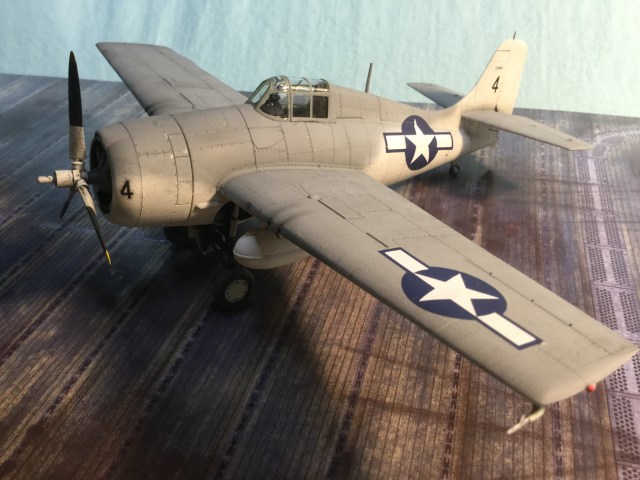
After the jump, let’s look at an Atlantic Wildcat.
Part of getting the aviation industry into high gear for the war involved spreading production among multiple sources. Grumman was building a number of key types for the Navy, so it seemed obvious enough to spread out the manufacture. This started with the mature F4F Wildcat. Grumman was partnered with General Motors, which caused much concern over if an automobile manufacturer could be taught to build to aviation production tolerances. The first step involved sending Grumman engineers to oversee the tooling up process. A few F4F-4 Wildcats were sent from Grumman in kit form for assembly at the new General Motors plant. By August of 1942 a trickle of new FM-1 Wildcats were being delivered. Early in 1943 General Motors was delivering planes faster than Grumman could and shortly they took over all Wildcat production.
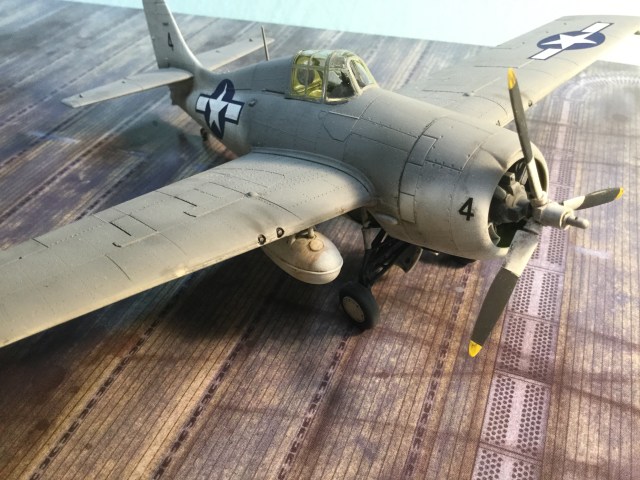
Notice the unusually shaped panel right below the front wind shield, and the long, narrow panel just ahead of it? That is an access panel for a nose mounted machine gun that was only equipped on the first TWO Wildcats. The panels remained unchanged for the entire production of the type. So I blanked off the outboard wing machine gun here because the FM-1 only had two in each wing, and I figured the panels were probably left alone.
The FM-1 Wildcat was nearly identical to the F4F-4, the last mass produced version from Grumman. The only visible difference is interesting. The FM-1 only had two .50 machine guns in each wing where the F4F-4 had three. The older F4F-3 only had two guns per wing, but when the British ordered the type they insisted on more firepower. In the cause of standardization it was decided all Wildcats should have the increased firepower, but this was broadly considered a mistake by pilots. In adding the extra gun to each wing, total ammunition supply was decreased to save weight. Pilots flying in the Pacific absolutely did not need or want the extra firepower, especially not at the expense of firing time (Japanese aircraft could not take much .50 cal damage!). Even in the Atlantic the change was not really appreciated; the M2 .50 is a very heavy hitting machine gun, far more so than the .303 used by the British. So heavier firepower at the expense of ammunition was a bad trade. The FM-1 deleted one gun, and added ammunition to each wing.
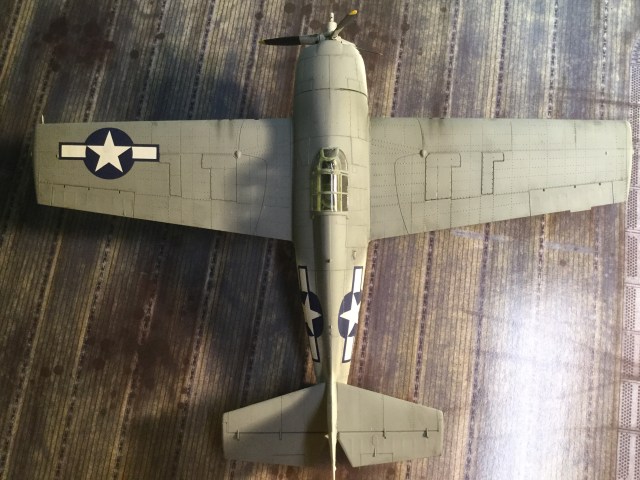
The FM-1 became available in numbers about the time the Wildcat was being phased out of front line combat and carrier groups; so many would serve with advanced training groups. But the new escort carriers had very limited deck and hanger space, and since they were not meant for a primary combat role the small Wildcat was felt to be the ideal fighter for these small ships. So the Wildcat continued to see combat in a support role all the way to the end of the war. The FM-1 was the main type from 1943 into early 1944 when improved FM-2 Wildcats came available.
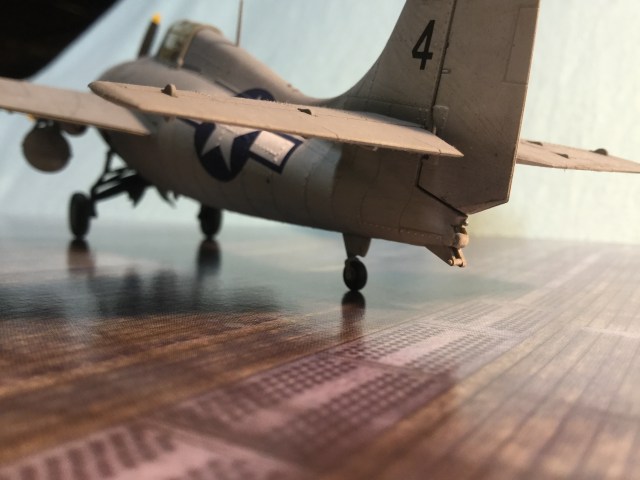
The escort carrier served several functions. Its name comes from its primary function of escorting slower transport convoys, but they also provided close support for invasion forces and transported fully assembled aircraft. In early 1944 several were assigned to independent Hunter-Killer groups. These would operate in the Atlantic independent of convoys and hunt down U-Boats wherever they might be.
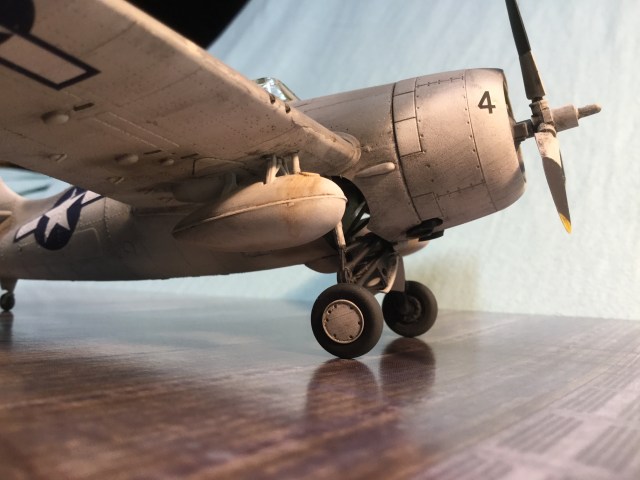
The plane here was assigned the USS Guadalcanal in 1944. The Guadalcanal, under Capt Daniel Gallery, was the lead ship of one such Hunter-Killer group. This group has two claims to fame. The first being a bold decision to conduct night-time strike operations. The ship’s bombers, TBM Avengers, could not stay up all night long with any load other than fuel. The Germans were starting to figure this out and were getting bold about staying on the surface all night long to charge batteries or take on supplies. So when Capt Gallery received intel of a German resupply operation occurring within his reach he launched an eight plane strike that caught three U-Boats on the surface at dusk (1/16/44). All three were claimed sunk (at least one, the U-544, actually was destroyed). In the night landing after the strike, four of the eight Avengers were lost (I think all crews were rescued) one of which caused damage to the Guadalcanal when it went over the side. In April the Guadalcanal got two more U-Boats with middle of the night air strikes.

The second mission of note is even better known. Capt Gallery had been drilling his group’s crews in boarding and capturing operations. He was eager to get all the engineering data and code books off of an operational boat. The opportunity came on June 4, 1944. The U-505 was damaged by attacks involving both destroyers and air attack. When it was forced to the surface a boarding party from the destroyer USS Pillsbury captured the sub. The captain of the U-505 had ordered his boat scuttled before he committed suicide, but the boarding party secured the boat and captured codes included the Kreigsmarine Enigma Machine. The U-505 was towed to Bermuda as the first war prize of the US Navy since the War of 1812. The whole group received a Presidential Unit Citation; and Lt David, commander of the Pillsbury boarding party, got the Medal of Honor. Today, the U-505 can be seen at The Museum of Science and Industry in Chicago.

The air group on an Escort Carrier was Wildcats and Avengers; about 30 planes total in various mixes.
But there is a less known twist on this story. If you look up the USS Guadalcanal on Wikipedia you’ll get the details I just mentioned. But that is all sourced from Capt Gallery’s own writings. It doesn’t mention that all Hunter-Killer Groups had standing orders not to capture any U-Boats. When Admiral King, Chief of US Naval Operations (the highest office in the Navy), first heard about the capture he was livid and ordered the arrest and court martial of Capt. Gallery. Because, The Americans and British were already reading most German codes and did not want the Germans to know their codes had been compromised. After careful consideration Admiral King changed his mind and set out to cover up the capture (until after the war). The U-Boat crew was detained separately from all other POWs and all mention of the capture was kept out of the press. A vague report was released of a U-Boat sinking at that location and the Germans were none the wiser. The successful cover up may have been a more heroic accomplishment than the capture itself.

An FM-1 Wildcat on an Escort Carrier. (from forum.valka.cz)
This aircraft is from the Tamiya kit with Aeromaster decals. I did a very simple conversion to make this an FM-1, perhaps too simple. I just blanked off the gun ports on the leading edge of the wing and left the access panels in the wing alone (thinking that new wing sections probably weren’t designed until the next full new model, the FM-2). The more pictures I look at, the more I’m thinking FM-1 Wildcats actually DID have new wing panels that smoothed over those access points. Bummer.
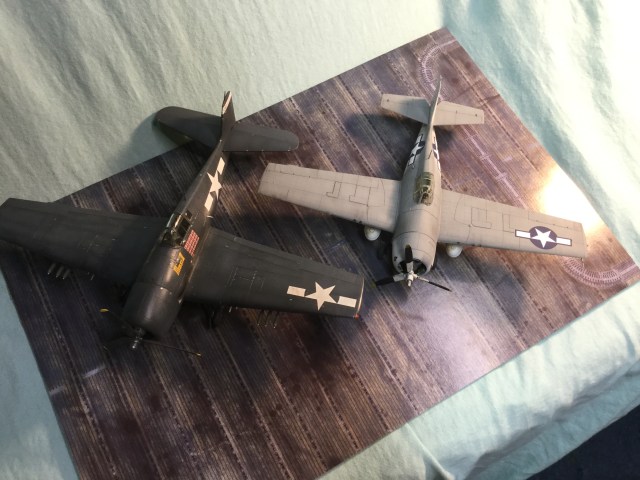
The Hellcat was the standard fighter on Fleet Carriers from mid-1943 to the end of the war. But space was critical on the smaller Escort Carriers, so the older, smaller Wildcat was standard instead.
Navy aircraft serving in the Atlantic as Anti-Submarine hunters wore a less familiar Grey/White color scheme. This was about low visibility from the water’s surface, usually against a grey, overcast sky. Speaking from first hand experience, white is very difficult to see against an overcast (whoever decided white was the best color for GA aircraft clearly was no friend of air traffic controllers!)

The U-505 under tow

…and on display in its new home in Chicago (from msichicago.org)

Terrific kit and a great post again Dave. The Battle for the Atlantic is often overlooked, it is particularly fascinating to read that the Allies didn’t want a U-boat to be captured as they already had an enigma machine. I imagine such an incident would be a disaster for the intelligence operatives at Bletchley Park. Very interesting stuff.
Yeah I’m thinking Capt Gallery might have been shot if those codes had changed!
I’m not exactly sure what all the allies were reading at that time. Most accounts indicate some good Intel was gained from the capture, but it wasn’t quite the mother lode the Capt expected it to be.
It used to frustrate me a lot that “the whole story” wasn’t routinely told. But maybe I’ve mellowed with age. It seems so many people are eager to spoil our heroes anymore I’m perfectly happy that the “better” angle of this story is how it’s normally told.
A lovely pair of examples you have there Dave, and a. Great story to boot.
Thanks AT.
A beautifully made kit, as always. Looking at the Wildcat though, I always feel that it is the illicit offspring of some liaison involving at least one Brewster Buffalo!
Well they were both designed around the same engine! Some of it may be the aesthetic of the age; like a scaled up Gee Bee. The Soviet I-16 and American P-35 are sort of the same barrel shape too.
But other than that, you know, watch your language! the Wildcat won battles; the Buffalo did not, at least not in American or British service.
I know I say this many times…
My favorite plane.
I’m the same way, if it has wings and propellers it could be “my favorite plane”!
Very interesting post with things I didn’t know especially the captured submarine story.
That’s always great to hear.
Reblogged this on My Forgotten Hobby and commented:
A beautiful rendition of the real airplane
In the hands of an expert pilot using tactical advantage, the Wildcat could prove to be a difficult foe even against the formidable Zero.
Yes absolutely!
I wrote a little more about that over in the F4F-4/John Thach post. Thanks to great tacticians and a professional core of pre-war pilots the Navy and Marine Corps did quite well against the Zero.
The last image can’t be seen.
Thanks, I’ll fix that.